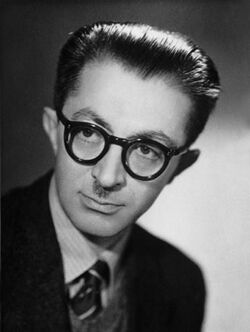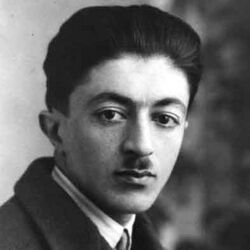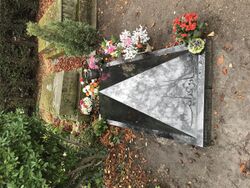Biography:Sadegh Hedayat
Sadegh Hedayat | |
|---|---|
 The last photograph he posted from Paris to his relatives in Tehran. (1951) | |
| Born | Tehran, Imperial Iran |
| Died | 9 April 1951 (aged 48) Paris, France |
| Resting place | Père Lachaise Cemetery |
| Alma mater | Dar ul-Funun St. Louis School University of Tehran |
| Known for | Writer of prose fiction and short stories |
Notable work | The Blind Owl (Bufe kur) Buried Alive (Zende be gur) The Stray Dog (Sage velgard) Three Drops of Blood (Seh ghatreh khoon) |
Sadegh Hedayat (Persian: صادق هدایت Persian pronunciation: [ˈsɑːdɛq ɛ hɛdɑːˈjæt] ![]() listen (help·info); 17 February 1903 – 9 April 1951) was an Iranian writer and translator. Best known for his novel The Blind Owl, he was one of the earliest Iranian writers to adopt literary modernism in their career.
listen (help·info); 17 February 1903 – 9 April 1951) was an Iranian writer and translator. Best known for his novel The Blind Owl, he was one of the earliest Iranian writers to adopt literary modernism in their career.
Early life and education
Hedayat was born to a northern Iranian aristocratic family in Tehran. His great-grandfather Reza-Qoli Khan Hedayat Tabarestani was a well-respected writer and worked in the government, as did other relatives. Hedayat's sister married Haj Ali Razmara who was an army general and among the prime ministers of Iran under Shah Mohammad Reza Pahlavi.Cite error: Closing </ref> missing for <ref> tag[1] Nadeem Akhtar's Hedayat in India[2] provides details of Hedayat's sojourn in India. In Bombay Hedayat completed and published his most enduring work, The Blind Owl, which he had started writing, in Paris, as early as 1930. The book was praised by Henry Miller, André Breton, and others, and Kamran Sharareh has called it "one of the most important literary works in the Persian language".[3]
Vegetarianism
Hedayat was a vegetarian from his youth and authored the treatise The Benefits of Vegetarianism whilst in Berlin in 1927.[4]
Death and legacy
In 1951, overwhelmed by despair, Hedayat left Tehrān and traveled to Paris, where he rented an apartment. A few days before his death, Hedayat tore up all of his unpublished work. On 9 April 1951, he plugged all the doors and windows of his rented apartment with cotton, then turned on the gas valve, committing suicide by carbon monoxide poisoning. Two days later, his body was found by police, with a note left behind for his friends and companions that read, "I left and broke your heart. That is all."[5][6] He is widely remembered as "a major symbol of Iranian nationalism."[7]
The English poet John Heath-Stubbs published an elegy, "A Cassida for Sadegh Hedayat", in A Charm Against the Toothache in 1954.
Censorship
In November 2006, republication of Hedayat's work in uncensored form was banned in Iran, as part of a sweeping purge. However, surveillance of bookstalls is limited and it is still possible to purchase the originals second-hand. The official website is also still online. The issue of censorship is discussed in:
- "City Report: Tehran" in Frieze, issue 86, October 2004, which examines Iranian censorship in general;[8]
- An article by Robert Tait in The Guardian , 17 November 2006;[9]
- an article published by Radio Free Europe — Radio Liberty on 26 November 2007.[10]
Quotations
The Blind Owl
- In life there are certain sores that, like a canker, gnaw at the soul in solitude and diminish it. (opening line)
Pearl Cannon
- It is true that the Arabs were too lowly to do such insolence, this sedition was started by Jewish spies and they created (Islam) with their own hands to overthrow the civilization of Iran and Rome and they achieved their goal, but like the staff of Moses that He turned into a dragon and Moses himself was afraid of him, this seventy-headed dragon is devouring the world
Page 9
- The Irish were actually Iranians who migrated to Western Europe, tried to change the word "Iran", removed "an" and replaced it with "eland" and became "Ireland". Germanics were Iranians who migrated from Kerman province to the center of Europe. Page 25
Works
- Fiction
- 1930 Buried Alive (Zende be gūr) A collection of 9 short stories.
- 1931 Mongol Shadow (Sāye-ye Moqol)
- 1932 Three Drops of Blood (Se qatre khūn). A collection of 11 short stories.
- 1933 Chiaroscuro (Sāye-ye roushan) A collection of 7 short stories.
- 1934 Mister Bow Wow (Vagh Vagh Sahāb)
- 1936 Sampingé (in French)
- 1936 Lunatique (in French)
- 1936 The Blind Owl (Boof-e koor)
- 1942 The Stray Dog (Sag-e velgard). A collection of 8 short stories.
- 1943 Lady Alaviyeh (Alaviye Khānum)
- 1944 Velengārī (Tittle-tattle)
- 1944 The Elixir of Life (Āb-e Zendegi)
- 1945 The Pilgrim (Hājī āqā)
- 1946 Tomorrow (Fardā)
- 1947 The Pearl Cannon (Tūp-e Morvari)
- Drama (1930–1946)
- Parvin dokhtar-e Sāsān (Parvin, Sassan's Daughter)
- Māzīyār
- Afsāne-ye āfarīnesh (The Fable of Creation)
- Travelogues
- Esfahān nesf-e jahān (Isfahan: Half of the World)
- Rū-ye jādde-ye namnāk (On the Wet Road), unpublished, written in 1935.
- Studies, Criticism and Miscellanea
- Rubā'iyāt-e Hakim Omar-e Khayyām (Khayyam's Quatrains) 1923
- Ensān va heyvān (Man and Animal) 1924
- Marg (Death) 1927
- Favāyed-e Giyāhkhāri (The Advantages of Vegetarianism) 1927
- Hekāyat-e bā natije (The Story with a Moral) 1932
- Tarānehā-ye Khayyām (The Songs of Khayyam) 1934
- Chāykovski (Tchaikovsky) 1940
- Dar pirāmun-e Loqat-e Fārs-e Asadi (About Asadi's Persian Dictionary) 1940
- Shive-ye novin dar tahqiq-e adabi (A New Method of Literary Research) 1940
- Dāstan-e Nāz (The Story of Naz) 1941
- Shivehā-ye novin dar she'r-e Pārsi (New Trends in Persian Poetry) 1941
- A review of the film Molla Nasrud'Din 1944
- A literary criticism on the Persian translation of Gogol's The Government Inspector 1944
- Chand nokte dar bāre-ye Vis va Rāmin (Some Notes on Vis and Ramin) 1945
- Payām-e Kāfkā (The Message of Kafka) 1948
- Al-bi`tha al-Islamīya ilā al-bilād al-Afranjīya (The Islamic Mission to the European Lands), undated.
- Translations
- From French:
- 1931 Gooseberries by Anton Chekhov
- 1948 In the Penal Colony by Franz Kafka
- 1944 Before the Law by Franz Kafka
- 1950 The Metamorphosis by Franz Kafka (along with Hasan Qaemian)
- 1950 The Wall by Jean-Paul Sartre
- 1950 Tales of Two Countries by Alexander Kielland
- 1950 Blind Geronimo and his Brother by Arthur Schnitzler
- From Pahlavi:
- 1943 Kārname-ye Ardashir-e-Pāpākān (The Book of the Deeds of Ardashir [son of] Papakan)
- 1940 Gojaste Abālish
- 1945 Āmadan-e shāh Bahrām-e Varjavand (Return of shah Bahram Varjavand)
- 1944 Zand-i Wahman yasn
- From French:
Films about Hedayat
- In 1987, Raul Ruiz made the feature film La Chouette aveugle in France: a loose adaption of Hedayat's novel The Blind Owl. Its formal innovations led critics and filmmakers to declare the film 'French cinema's most beautiful jewel of the past decade.'[11]
- Hedayat's last day and the night was adapted into the short film, The Sacred and the Absurd, directed by Ghasem Ebrahimian, which was featured in the Tribeca Film Festival in 2004.
- In 2005, Iranian film director Khosrow Sinai has made a docudrama about Hedayat entitled Goftogu ba saye = Talking with a shadow. Its main theme is the influence of Western movies such as Der Golem, Nosferatu, and Dracula on Hedayat.
- In 2009, Mohsen Shahrnazdar and Sam Kalantari made a documentary film about Sadegh Hedayat named From No. 37.
See also
- Intellectual movements in Iran
- Persian literature
- Persian philosophy
Sources
- Hassan Kamshad, Modern Persian Prose Literature ISBN:0-936347-72-4
- Acquaintance with Sadegh Hedayat, by M. F. Farzaneh, Publisher: Markaz, Tehran, 2008.
- Sadeq Hedayat, the foremost short story writer of Iran
- The Sacred and the Absurd, a film about Hedayat's death
Further references
- Homa Katouzian, Sadeq Hedayat: Life and legend of an Iranian writer, I.B. Tauris, 2000. ISBN:1-86064-413-9
- Hassan Kamshad, Modern Persian Prose Literature, Ibex Publishers, 1996. ISBN:0-936347-72-4
- Michael C. Hillmann, Hedayat's "The Blind Owl" Forty Years After, Middle East Monograph No. 4, Univ of Texas Press, 1978.
- Iraj Bashiri, Hedayat's Ivory Tower: Structural Analysis of The Blind Owl, Minneapolis, Minnesota, 1975.
- Iraj Bashiri, The Fiction of Sadeq Hedayat, 1984.
- Sayers, Carol, The Blind Owl and Other Hedayat Stories, Minneapolis, Minnesota, 1984.
- What is left for me from Sadegh Hedayat? Excerpt from "Sadegh Hadayat: Dar Tare Ankaboot" (In the Spider's Web), by M. F. Farzaneh, 2005.
- Hedayat's last night out in Paris Excerpt from M. F. Farzaneh's "Ashenayee ba Sadegh Hedayat" (Knowning Sadegh Hedayat), 2004.
References
- ↑ Beard, Michael (2014-07-14) (in en). Hedayat's Blind Owl as a Western Novel. Princeton University Press. pp. 34. ISBN 978-1-4008-6132-3. https://books.google.com/books?id=Eh8ABAAAQBAJ&pg=PA34.
- ↑ electricpulp.com. "HEDAYAT, SADEQ v. Hedayat in India – Encyclopaedia Iranica". http://www.iranicaonline.org/articles/hedayat-sadeq-v.
- ↑ "From Persia to Tehr Angeles: A Contemporary Guide to Understanding and Appreciating Ancient Persian Culture", p. 126, by Kamran Sharareh
- ↑ Sollars, Michael; Jennings, Arbolina Llamas. (2008). The Facts on File Companion to the World Novel 1900 to the Present. Facts On File. p. 347. ISBN ISBN:978-1438108360
- ↑ Dohni, Niloufar (April 13, 2013). "A Man Out Of Place" (in en). https://eng.majalla.com/2013/04/article55240353/a-man-out-of-place.
- ↑ Kuiper, Kathleen, ed. "Sadeq Hedayat: Iranian author" (in en). https://www.britannica.com/biography/Sadeq-Hedayat.
- ↑ Amiri, Cyrus; Govah, Mahdiyeh (2021-09-22). "Hedayat's rebellious child: multicultural rewriting of The Blind Owl in Porochista Khakpour's Sons and Other Flammable Objects". British Journal of Middle Eastern Studies 50 (2): 436–449. doi:10.1080/13530194.2021.1978279. ISSN 1353-0194. https://doi.org/10.1080/13530194.2021.1978279.
- ↑ "Frieze Magazine | Archive | Tehran". Frieze.com. http://www.frieze.com/issue/article/city_report_tehran.
- ↑ Robert Tait in Tehran (2006-11-17). "Bestsellers banned in new Iranian censorship purge | World news". The Guardian. https://www.theguardian.com/international/story/0,,1950047,00.html.
- ↑ "Iran: Book Censorship The Rule, Not The Exception". Rferl.org. 2007-11-26. http://www.rferl.org/featuresarticle/2007/11/5b6fd277-6800-4454-9dc2-4dc43553fa02.html.
- ↑ "Excerpted from Trafic no. 18 (Spring 1996) Translation Rouge 2004". http://www.rouge.com.au/2/blind.html.
External links
- Sadeq Hedayat's Life by Iraj Bashiri.
- Sadeq Hedayat's Corner, further articles and English translations by Iraj Bashiri.
- Persian Language & Literature — Sadeq Hedayat.
- Hedayat's art work
- Audiobooks (Ketab-e Gooya).
- Hedayat Family History (in English).
- Sadeq Hedayat's Heritage, Jadid Online, 17 July 2008 (in English).
- An audio slideshow (with English subtitles) by Shokā Sahrāi, with Mr Jahāngir Hedayat (son of General Isā Hedayat, Sadegh Hedayat's brother) speaking. (6 min 28 sec).
 |




